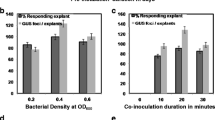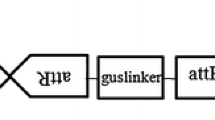Abstract
In this study, we developed a rapid and efficient method for in vitro propagation and Agrobacterium tumefaciens-mediated transformation of Digitalis purpurea L. (syn. foxglove), an important medicinal plant. Mature leaf explants of D. purpurea were used for 100 % adventitious shoot regeneration on Murashige and Skoog (MS) medium supplemented with 1 mg L−1 thidiazuron (TDZ) (a cytokine) and 0.1 mg L−1 1-naphthaleneacetic acid (NAA) (an auxin). Transformation was achieved by inoculating leaf explants with the A. tumefaciens strains GV2260/pBI121 or GV3101/pBI121. The binary vector pBI121 contained the reporter β-glucuronidase gene (GUS) and kanamycin selection marker nptII. Kanamycin-resistant shoots were regenerated directly on the selection medium 4–6 weeks after co-cultivation. Approximately, 52.2 and 60 % of kanamycin-resistant shoots transformed with Agrobacterium strains GV2260 and GV3101, respectively, showed strong GUS staining by histochemical assay. Furthermore, PCR and Southern blot analysis confirmed the presence of nptII and GUS on the chromosome of the transformed D. purpurea plants, and stable GUS expression was detected in the transformants by RT-PCR analysis. This efficient method of shoot regeneration and genetic transformation of D. purpurea will provide a powerful tool to increase and produce valuable components such as digitoxin, digoxin, and digoxigenin in D. purpurea through improved secondary metabolic pathways via a biotechnological approach.






Similar content being viewed by others
References
Albach, D. C., Meudt, H. M., & Oxelman, B. (2005). American Journal of Botany, 92, 297–315.
Saito, K., Yamazaki, M., Shimomura, K., Yoshimatsu, K., & Murakoshi, I. (1990). Plant Cell Reports, 9, 121–124.
Mastenbroek, C. (1985). British Heart Journal, 54, 262–268.
Navarro, E., Alonso, P., Alonso, S., Trujillo, J., Pérez, C., Toro, M. V., & Ayuso, M. J. (2000). Journal of Ethnopharmacology, 71, 437–442.
Pérez-Bermúdez, P., García, A. A. M., Tuñón, I., & Gavidia, I. (2010). New Phytologist, 185, 687–700.
Sharma, A., & Purkait, B. (2012). Journal of Analytical Methods in Chemistry. doi 10.1155/2012/109058.
Haux, J. (1999). Medical Hypotheses, 53, 543–548.
Haux, J., Klepp, O., Spigset, O., & Tretli, S. (2001). BMC Cancer, 1, 11.
López-Lázaro, M. (2007). Expert Opinion on Therapeutic Targets, 11, 1043–1053.
Wu, B., Li, Y., Yan, H., Ma, Y., Luo, H., Yuan, L., Chen, S., & Lu, S. (2012). BMC Genomics, 13, 15.
Menger, L., Vacchelli, E., Kepp, O., Eggermont, A., Tartour, E., Zitvogel, L., Kroemer, G., & Galluzzi, L. (2013). Oncoimmunology, 2, e23082.
Sato, M., Murao, K., Mizobuchi, M., & Takahara, J. (1993). Biotechnology, 15, 880–882.
McCabe, M. S., Power, J. B., de Laat, A. M., & Davey, M. R. (1997). Molecular Biotechnology, 7, 79–84.
Kim, M., Cui, M., Cubas, P., Gillies, A., Lee, K., Chapman, M. A., Abbott, R. J., & Coen, E. (2008). Science, 322, 1116–1119.
Kreis, W., May, U., & Reinhard, E. (1986). Plant Cell Reports, 5, 442–445.
Koga, K., Hirashima, K., & Nakahara, T. (2000). Plant Biotechnology, 17, 99–104.
Kuate, S. P., Pádua, R. M., Eisenbeiss, W. F., & Kreis, W. (2008). Phytochemistry, 69, 619–626.
Verpoorte, A., & Memelink, J. (2002). Phytochemistry Reviews, 1, 13–25.
Vanisree, M., & Tsay, H. S. (2004). International Journal of Applied Science and Engineering, 2, 29–48.
Gurel, E., Yucesan, B., Aglic, E., Gurel, S., Verma, S. K., Sokmen, M., & Sokmen, A. (2011). Plant Cell, Tissue and Organ Culture, 104, 217–225.
Pérez-Alonso, N., Capote, A., Gerth, A., & Jiménez, E. (2012). Plant Cell, Tissue and Organ Culture, 110, 153–162.
Murashige, T., & Skoog, F. (1962). Physiologia Plantarum, 15, 81–84.
Jefferson, R. A., Kavanagh, T. A., & Bevan, M. W. (1987). EMBO Journal, 63, 901–3907.
Deblaere, R., Bytebier, B., De Greve, H., Deboeck, F., Schell, J., Van Montagu, M., & Leemans, J. (1985). Nucleic Acids Research, 13, 4777–4785.
Koncz, C., & Shell, J. (1986). Molecular and General Genetics, 204, 383–396.
Shen, W. J., & Forde, B. G. (1989). Nucleic Acids Research, 17, 8385.
Rogers, S. O., & Bendich, A. J. (1985). Plant Molecular Biology, 5, 69–76.
Patil, J. G., Ahire, M. L., Nitnaware, K. M., Panda, S., Bhatt, V. P., Kishor, P. B., & Nikam, T. D. (2013). Applied Microbiology and Biotechnology, 97, 2379–2393.
Sales, E., Nebauer, S. G., Arrillaga, I., & Segura, J. (2002). Journal of Plant Physiology, 159, 9–16.
Cui, M., Ezura, H., Nishimura, S., Kamada, H., & Handam, T. (2004). Plant Science, 166, 873–879.
Cui, M., Ichikawa, H., Sage-Ono, K., Kamada, H., & Handa, T. (2003). Journal of Horticultural Science & Biotechnology, 78, 394–399.
Sales, E., Segura, J., & Arrillaga, I. (2003). Planta Medica, 69, 143–147.
Acknowledgments
This work was supported by a grant from Yunnan provincial Science and Technology Department (no. 2012IB001) to MLC.
Author information
Authors and Affiliations
Corresponding author
Rights and permissions
About this article
Cite this article
Li, Y., Gao, Z., Piao, C. et al. A Stable and Efficient Agrobacterium tumefaciens-Mediated Genetic Transformation of the Medicinal Plant Digitalis purpurea L.. Appl Biochem Biotechnol 172, 1807–1817 (2014). https://doi.org/10.1007/s12010-013-0648-6
Received:
Accepted:
Published:
Issue Date:
DOI: https://doi.org/10.1007/s12010-013-0648-6




